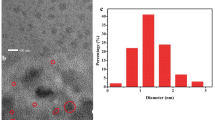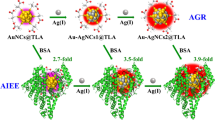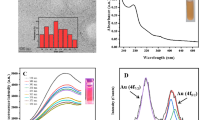Abstract
A facile one-pot method for synthesis of bovine serum albumin (BSA)-gold nanoclusters (AuNCs) has been developed. The formation of BSA-AuNCs took only 30 s under mild conditions. BSA-AuNCs exhibited strong orange-yellow fluorescence, and the excitation and emission peaks were at 370 nm and 564 nm, respectively. In the process of forming BSA-AuNCs, the molecular chain of BSA has not been destroyed. Moreover, there were a large number of Au cations on the surface of BSA-AuNCs, which had strong oxidizing abilities. The reason for the ultrabright fluorescence of BSA-AuNCs was attributed to the Au(0)@Au(I)@Au(III)-ligand structure on the surface of BSA. In order to evaluate the fluorescence performance of BSA-AuNCs, BSA-AuNCs was used as a probe, realizing the sensitive and selective determination of glutathione (GSH) in a wide linear range of 0.01–0.48 μM and a detection limit of 3.3 nM. The proposed method not only offers a brand-new scheme for synthesizing BSA-AuNCs, but also provides a platform for studying the interaction between metal core and proteins.
Graphical abstract

A facile one-pot method to synthesize ultrabright fluorescent BSA-AuNCs in tens of seconds has been introduced by mixing BSA suspension, KSCN, and HAuCl4. The as-prepared BSA-AuNCs showed intensive orange-yellow fluorescence under a UV lamp (365 nm), and BSA still keeps the integral molecular chains during the whole synthesis process. Moreover, the as-prepared BSA-AuNCs have realized the sensitive and selective detection of glutathione (GSH) in a wide linear range of 0.01–0.48 μM and a detection limit of 3.3 nM







Similar content being viewed by others
References
Davila J, Harriman A (1990) Photochemical and radiolytic oxidation of a zinc porphyrin bound to human serum albumin. J Am Chem Soc 112(7):2686–2690
Miškovský P, Jancura D, Sánchez-Cortés S, KočIšová E, Chinsky L (1998) Antiretrovirally active drug hypericin binds the IIA subdomain of human serum albumin: resonance Raman and surface-enhanced Raman spectroscopy study. J Am Chem Soc 120(25):6374–6379
Lai L, Wei XQ, Huang WH, Mei P, Ren ZH, Liu Y (2017) Impact of carbon quantum dots on dynamic properties of BSA and BSA/DPPC adsorption layers. J Colloid Interface Sci 506:245–254
He XM, Carter DC (1992) Atomic structure and chemistry of human serum albumin. Nature 358(6383):209–215
Zolese G, Falcioni G, Bertoli E, Galeazzi R, Wozniak M, Wypych Z, Gratton E, Ambrosini A (2000) Steady-state and time resolved fluorescence of albumins interacting with N-oleylethanolamine, a component of the endogenous N-acylethanolamines. Proteins Struct Funct Genet 40(1):39–48
Guo Z, Zhu S, Yong Y, Zhang X, Dong X, Du J, Xie J, Wang Q, Gu Z, Zhao Y (2017) Synthesis of BSA-coated BiOI@Bi2S3 semiconductor heterojunction nanoparticles and their applications for radio/photodynamic/photothermal synergistic therapy of tumor. Adv Mater 29(44):1704136
Wang Y, Wu Y, Liu Y, Shen J, Lv L, Li L, Yang L, Zeng J, Wang Y, Zhang LW, Li Z, Gao M, Chai Z (2016) BSA-mediated synthesis of bismuth sulfide nanotheranostic agents for tumor multimodal imaging and thermoradiotherapy. Adv Funct Mater 26(29):5335–5344
Ji SB, Yan ZH, Wu JW, Chen LL, Li H (2013) One-step electrochemically co-assembled redox-active [Ru(bpy)2(tatp)]2+-BSA-SWCNTs hybrid film for non-redox protein biosensors. Biosens Bioelectron 39(1):106–111
Lee J, Park IS, Kim H, Woo JS, Choi BS, Min DH (2015) BSA as additive: a simple strategy for practical applications of PNA in bioanalysis. Biosens Bioelectron 69:167–173
Xie J, Zheng Y, Ying JY (2009) Protein-directed synthesis of highly fluorescent gold nanoclusters. J Am Chem Soc 131(3):888–889
Wei W, Lu Y, Chen W, Chen S (2011) One-pot synthesis, photoluminescence, and electrocatalytic properties of subnanometer-sized copper clusters. J Am Chem Soc 133(7):2060–2063
Dong L, Li M, Zhang S, Li J, Shen G, Tu Y, Zhu J, Tao J (2015) Cytotoxicity of BSA-stabilized gold nanoclusters: in vitro and in vivo study. Small 11(21):2571–2581
Chen Y, Wang Y, Wang C, Li W, Zhou H, Jiao H, Lin Q, Yu C (2013) Papain-directed synthesis of luminescent gold nanoclusters and the sensitive detection of Cu2+. J Colloid Interface Sci 396:63–68
Zhao M, Chen AY, Huang D, Zhuo Y, Chai YQ, Yuan R (2016) Cu Nanoclusters: novel electrochemiluminescence emitters for bioanalysis. Anal Chem 88(23):11527–11532
Zhou Q, Lin Y, Xu M, Gao Z, Yang H, Tang D (2016) Facile synthesis of enhanced fluorescent gold-silver bimetallic nanocluster and its application for highly sensitive detection of inorganic pyrophosphatase activity. Anal Chem 88(17):8886–8892
Dai H, Shi Y, Wang Y, Sun Y, Hu J, Ni P, Li Z (2014) Label-free turn-on fluorescent detection of melamine based on the anti-quenching ability of Hg2+ to gold nanoclusters. Biosens Bioelectron 53:76–81
Wu X, He X, Wang K, Xie C, Zhou B, Qing ZJN (2010) Ultrasmall near-infrared gold nanoclusters for tumor fluorescence imaging in vivo. Nanoscale 2(10):2244–2249
Liu CL, Wu HT, Hsiao YH, Lai CW, Shih CW, Peng YK, Tang KC, Chang HW, Chien YC, Hsiao JK, Cheng JT, Chou PT (2011) Insulin-directed synthesis of fluorescent gold nanoclusters: preservation of insulin bioactivity and versatility in cell imaging. Angew Chem Int Ed 50(31):7056–7060
Lin J, Zhou Z, Li Z, Zhang C, Wang X, Wang K, Gao G, Huang P, Cui D (2013) Biomimetic one-pot synthesis of gold nanoclusters/nanoparticles for targeted tumor cellular dual-modality imaging. Nanoscale Res Lett 8:170
Yan L, Cai Y, Zheng B, Yuan H, Guo Y, Xiao D, Choi MMF (2012) Microwave-assisted synthesis of BSA-stabilized and HSA-protected gold nanoclusters with red emission. J Mater Chem 22(3):1000–1005
Varlan A, Hillebrand M (2010) Bovine and human serum albumin interactions with 3-carboxyphenoxathiin studied by fluorescence and circular dichroism spectroscopy. Molecules 15(6):3905–3919
Pyo K, Thanthirige VD, Kwak K, Pandurangan P, Ramakrishna G, Lee D (2015) Ultrabright luminescence from gold nanoclusters: rigidifying the Au(I)-thiolate shell. J Am Chem Soc 137(25):8244–8250
Aires A, Llarena I, Moller M, Castro-Smirnov J, Cabanillas-Gonzalez J, Cortajarena AL (2019) A simple approach to design proteins for the sustainable synthesis of metal nanoclusters. Angew Chem Int Ed 58(19):6214–6219
Jia SM, Liu XF, Kong DM, Shen HX (2012) A simple, post-additional antioxidant capacity assay using adenosine triphosphate-stabilized 2,2′-azinobis(3-ethylbenzothiazoline)-6-sulfonic acid (ABTS) radical cation in a G-quadruplex DNAzyme catalyzed ABTS-H2O2 system. Biosens Bioelectron 35(1):407–412
Topala T, Bodoki A, Oprean L, Oprean R (2014) Bovine serum albumin interactions with metal complexes. Clujul Med 87(4):215–219
Dixon JM, Egusa S (2018) Conformational change-induced fluorescence of bovine serum albumin-gold complexes. J Am Chem Soc 140(6):2265–2271
Luo Z, Yuan X, Yu Y, Zhang Q, Leong DT, Lee JY, Xie J (2012) From aggregation-induced emission of Au(I)-thiolate complexes to ultrabright Au(0)@Au(I)-thiolate core-shell nanoclusters. J Am Chem Soc 134(40):16662–16670
Yang L, Chen J, Huang T, Huang L, Sun Z, Jiang Y, Yao T, Wei S (2017) Red-emitting Au7 nanoclusters with fluorescence sensitivity to Fe2+ ions. J Mater Chem C 5(18):4448–4454
Huang R, Wang BB, Si-Tu XM, Gao T, Wang FF, He H, Fan XY, Jiang FL, Liu Y (2016) A lysosome-targeted fluorescent sensor for the detection of glutathione in cells with an extremely fast response. Chem Commun 52(77):11579–11582
Peng HP, Jian ML, Huang ZN, Wang WJ, Deng HH, Wu WH, Liu AL, Xia XH, Chen W (2018) Facile electrochemiluminescence sensing platform based on high-quantum-yield gold nanocluster probe for ultrasensitive glutathione detection. Biosens Bioelectron 105:71–76
Pastore A, Massoud R, Motti C, Russo AL, Fucci G, Cortese C, Federici G (1998) Fully automated assay for total homocysteine, cysteine, cysteinylglycine, glutathione, cysteamine, and 2-mercaptopropionylglycine in plasma and urine. Clin Chem 44(4):825–832
Jalili R, Khataee A, Rashidi M-R, Luque R (2019) Dual-colored carbon dot encapsulated metal-organic framework for ratiometric detection of glutathione. Sensors Actuators B Chem 297:126775
Zhang J, Bao X, Zhou J, Peng F, Ren H, Dong X, Zhao W (2016) A mitochondria-targeted turn-on fluorescent probe for the detection of glutathione in living cells. Biosens Bioelectron 85:164–170
Tian L, Zhao W, Li L, Tong Y, Peng G, Li Y (2017) Multi-talented applications for cell imaging, tumor cells recognition, patterning, staining and temperature sensing by using egg white-encapsulated gold nanoclusters. Sensors Actuators B Chem 240:114–124
Bhamore JR, Jha S, Singhal RK, Murthy ZVP, Kailasa SK (2019) Amylase protected gold nanoclusters as chemo- and bio- sensor for nanomolar detection of deltamethrin and glutathione. Sensors Actuators B Chem 281:812–820
Lu W, Qin X, Liu S, Chang G, Zhang Y, Luo Y, Asiri AM, Al-Youbi AO, Sun X (2012) Economical, green synthesis of fluorescent carbon nanoparticles and their use as probes for sensitive and selective detection of mercury(II) ions. Anal Chem 84(12):5351–5357
Singh N, Chandra R (2021) Probing the binding interaction of ortho-vanillin derived chalcone with lysozyme: a biophysical studies aided by in silico calculations. J Mol Liq 321:114490
Mills BJ, Stinson CT, Liu MC, Lang CA (1997) Glutathione and cyst(e)ine profiles of vegetables using high performance liquid chromatography with dual electrochemical detection. J Food Compos Anal 10(2):90–101
Acknowledgements
We would like to thank the Analytical and Testing Center of Sichuan University for structure and microscopy work and we would be grateful to Tian Yunfei for his help in XPS analysis.
Funding
This work is financially supported by the National Natural Science Foundation of China (No. U1833124, 21876117 and U1833202).
Author information
Authors and Affiliations
Corresponding author
Ethics declarations
Conflict of interest
The authors declare that they have no conflict of interest.
Additional information
Publisher’s note
Springer Nature remains neutral with regard to jurisdictional claims in published maps and institutional affiliations.
Supplementary information
ESM 1
(DOCX 30893 kb)
Rights and permissions
About this article
Cite this article
Wang, T., Xiao, D. Rapid synthesis of fluorescent bovine serum albumin-gold nanoclusters complex for glutathione determination. Microchim Acta 188, 193 (2021). https://doi.org/10.1007/s00604-021-04844-8
Received:
Accepted:
Published:
DOI: https://doi.org/10.1007/s00604-021-04844-8




